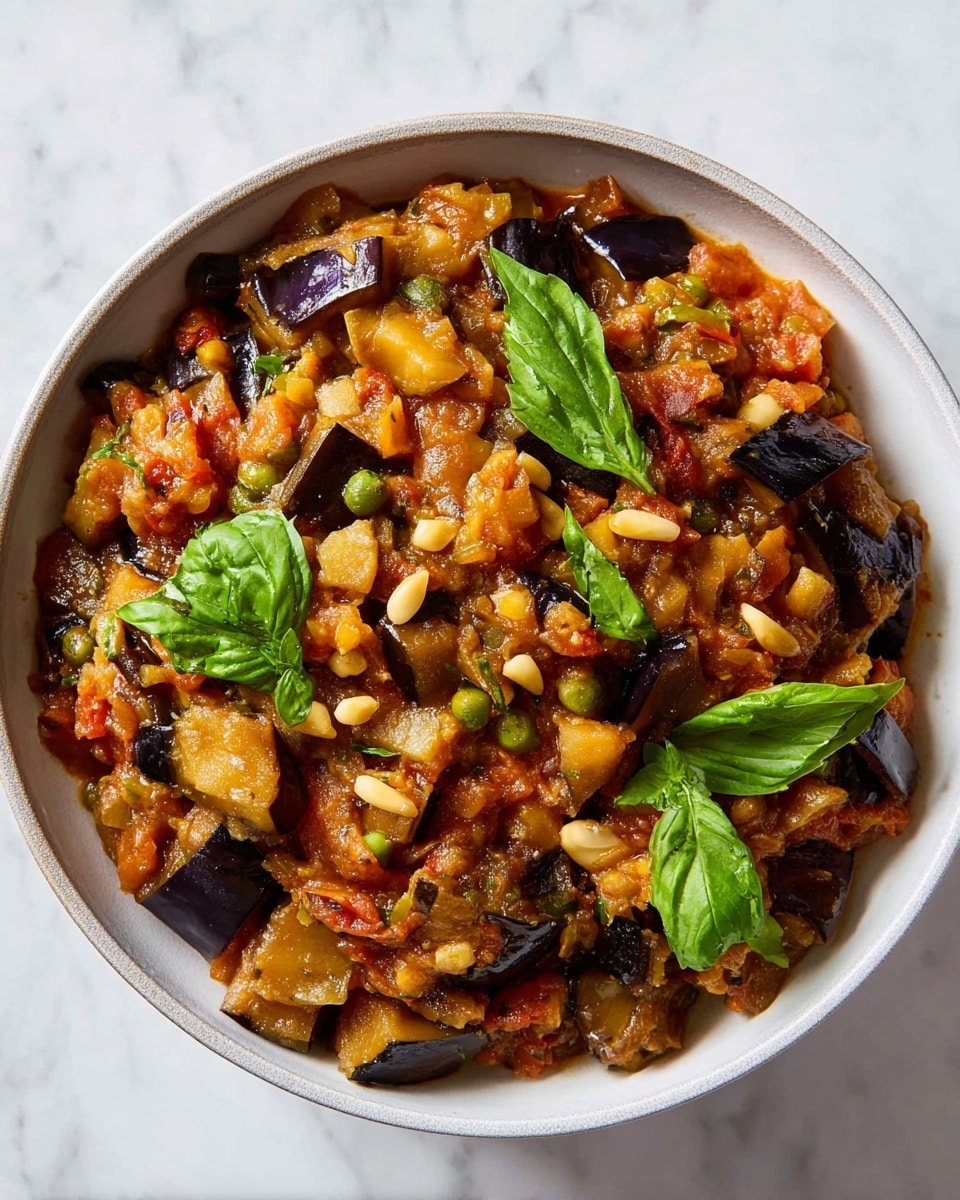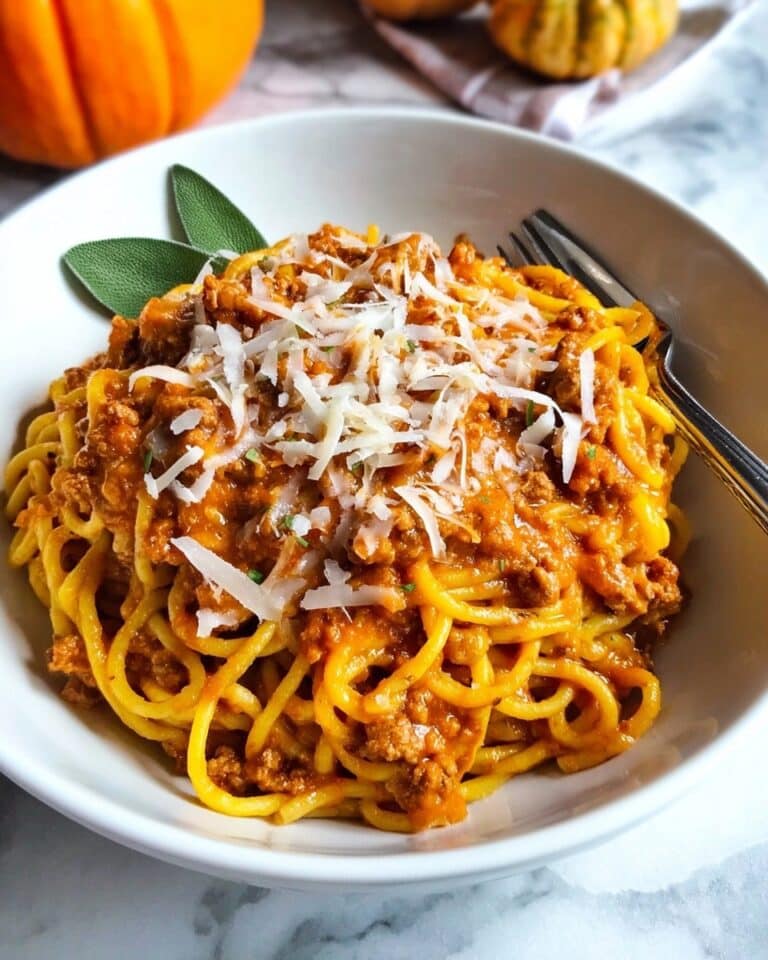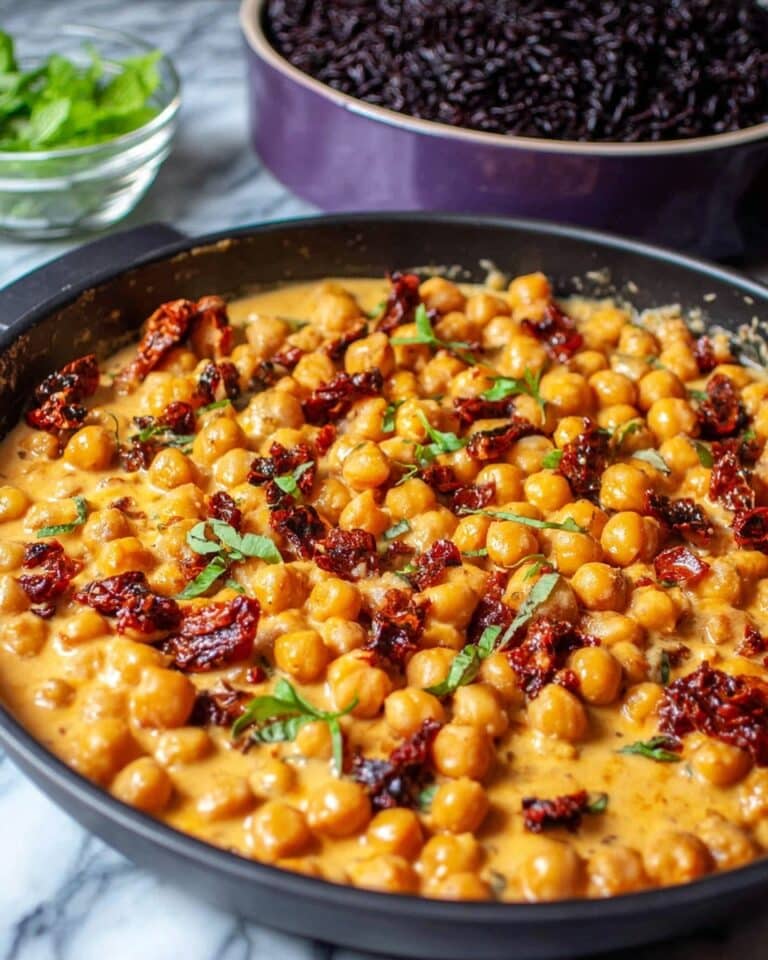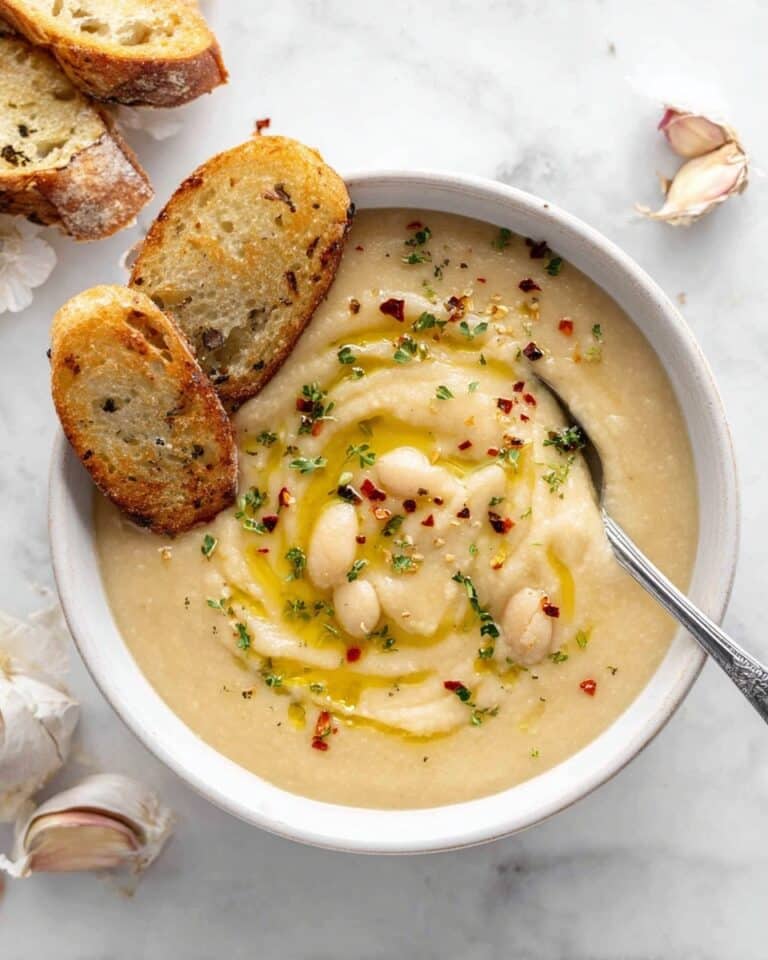- Eggplant: I prefer globe eggplants for their creamy texture once roasted.
- Olive Oil: Use a good quality extra virgin olive oil to boost flavor.
- Kosher Salt: Its larger grain helps season evenly.
- Yellow Onion: Adds sweetness and depth when lightly sautéed.
- Celery: For that subtle crunch and aromatic bite.
- Whole Peeled Tomatoes: Canned are fine, just break them up well for that saucy goodness.
- Red Wine Vinegar: It gives that iconic tang to caponata.
- Granulated Sugar: Balances acidity and enhances sweetness naturally.
- Pine Nuts: Toasted to add rich, nutty texture.
- Capers: Their briny punch brightens the dish.
- Black Olives: They bring a hearty, savory finish.
- Fresh Basil: Torn over the top for a fresh herbal note.
Note: Exact ingredients and measurements are listed in the recipe card below.
Variations
I love how this Eggplant Caponata Recipe can flex depending on what you have in your pantry or your taste preferences. Feel free to adjust ingredients or toss in complementary veggies to make it your own.
- Additional Vegetables: I sometimes add diced bell peppers or zucchini when I want extra color and texture.
- Vegan Version: This recipe is already plant-based, but make sure your sugar is vegan if that’s important to you.
- Herbs Switch-up: Try oregano or parsley instead of basil for fresh variations; I’ve found basil works best for the classic flavor, though.
- Heat Factor: A pinch of red pepper flakes adds a nice gentle kick if you enjoy a bit of spice.
How to Make Eggplant Caponata Recipe
Step 1: Roast the Eggplant for Creamy Goodness
Start by preheating your oven to 425°F and arranging two racks so you can roast your eggplants on two large baking sheets. Toss the diced eggplant with olive oil and salt, then spread them evenly in a single layer. Roasting is key here because it brings a beautiful caramelized flavor and soft texture—as they turn golden and tender, about 25 minutes, you’ll know it’s time to move on. Don’t forget to toss halfway through so everything cooks evenly!
Step 2: Build the Flavor Base with Onion, Celery, and Tomatoes
While the eggplants roast, heat up your skillet with the remaining olive oil and sauté the diced onion until it’s translucent and lightly golden—about 4 minutes. Add sliced celery, canned tomatoes along with their juices, vinegar, and sugar, stirring as you break up the tomatoes. Bring this mixture to a gentle simmer to meld the sweet and tangy flavors perfectly before combining with the eggplant.
Step 3: Let the Magic Happen: Simmer and Meld
Once your eggplant is ready, add it along with pine nuts and capers to the skillet. Bring everything to a boil, then reduce the heat to medium-low and cover. Let this simmer for about 30 minutes, stirring occasionally, until the eggplant becomes meltingly tender and the sauce is thick and flavorful. Keep an eye out and add a splash of water if the mixture starts sticking to the pan.
Step 4: Final Touches with Olives and Basil
Turn off the heat and stir in the chopped black olives for that salty, meaty finish. Then, tear fresh basil leaves over the top—it’s such a simple addition but the aromas elevate the whole dish beautifully. You can serve your Eggplant Caponata warm or cold depending on your mood or the occasion.
Pro Tips for Making Eggplant Caponata Recipe
- Roast Eggplant Evenly: Cut your eggplant into uniform pieces so they cook at the same rate and get that lovely golden crust.
- Control Acidity: Taste as you go with the vinegar and sugar—adjust slightly to balance brightness and sweetness perfectly for your palate.
- Simmer Gently: Keep the heat low once boiling to avoid burning and to allow flavors to slowly meld into that classic caponata richness.
- Avoid Watery Mixture: Use a wide pan for roasting and simmering to help moisture evaporate, preventing sogginess.
How to Serve Eggplant Caponata Recipe
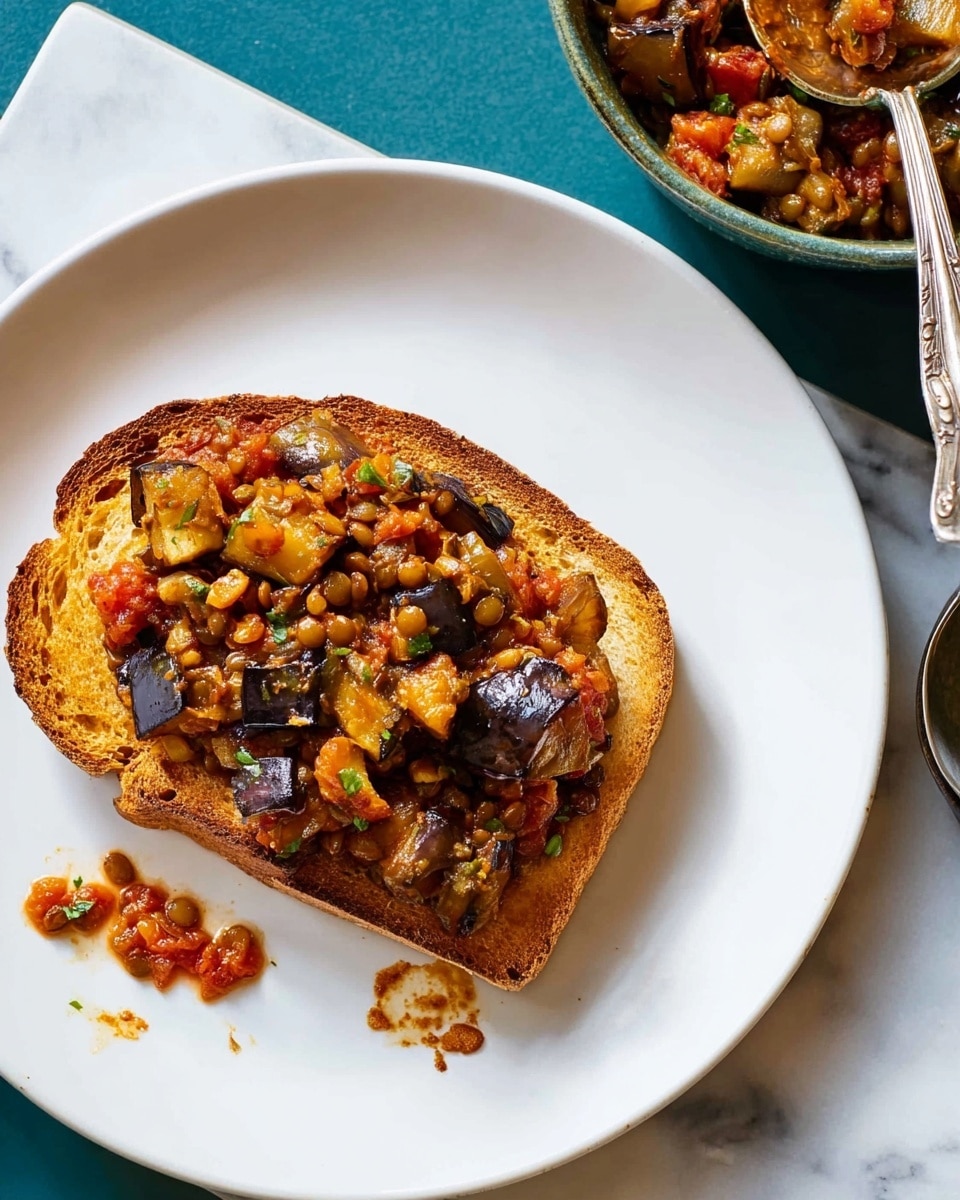
Garnishes
I’m a huge fan of finishing Eggplant Caponata with fresh torn basil for that burst of color and herbal aroma. Sometimes I add a sprinkle of toasted pine nuts on top, which gives a nice crunch and rich nutty flavor that complements the softness of the eggplant.
Side Dishes
This dish pairs beautifully with crusty bread or warm focaccia to scoop up all the saucy goodness. For a heartier meal, I like serving it alongside grilled chicken or a simply roasted fish. It’s also fantastic atop a bed of creamy polenta or alongside some fluffy couscous to soak up the flavors.
Creative Ways to Present
For a dinner party, I’ve served eggplant caponata in small glass jars or on toasted crostini as individual appetizers. It’s also beautiful layered in a shallow dish with fresh herbs, pine nuts, and olives scattered artistically. The vibrant colors make it a showstopper on any buffet or antipasto platter.
Make Ahead and Storage
Storing Leftovers
One of the things I adore about this Eggplant Caponata Recipe is how well it stores. I keep leftovers in an airtight container in the fridge for up to 4 days, and honestly, the flavors deepen and taste even better after sitting for a day or two.
Freezing
Freezing caponata is a great option if you want to save time in the future. I freeze portions in freezer-safe containers and find that it holds up surprisingly well. Just thaw overnight in the fridge before reheating gently.
Reheating
Reheat your caponata slowly on the stovetop over low heat, stirring occasionally to prevent sticking. I avoid the microwave because gentle warming preserves the dish’s texture better, keeping the eggplant creamy and the sauce luscious.
FAQs
-
Can I make Eggplant Caponata Recipe ahead of time?
Absolutely! In fact, Eggplant Caponata tastes even better after resting for at least a few hours or overnight, which allows the flavors to meld beautifully.
-
Is Eggplant Caponata Recipe gluten-free?
Yes, this traditional recipe is naturally gluten-free as it’s made with vegetables, vinegar, and nuts without any wheat-containing ingredients.
-
Can I substitute other vegetables in this caponata?
You sure can! Bell peppers, zucchini, or even mushrooms can be added or swapped in for a different twist, though eggplant remains the star of the dish.
-
What’s the best way to serve Eggplant Caponata Recipe?
Serve it warm or chilled as an appetizer, side dish, or spread on toasted bread—the versatility is part of its charm!
Final Thoughts
This Eggplant Caponata Recipe holds a special place in my kitchen because it’s so easy to make and reliably delicious every time. Whether you’re making it for a relaxed family lunch or an elegant appetizer for guests, it always impresses and brings smiles around the table. Trust me—you’ll enjoy discovering how a few simple ingredients can come together into something truly memorable and comforting. Give it a try and make it your own; I have a feeling it might just become a favorite in your home too!
I absolutely love sharing this Eggplant Caponata Recipe with friends because it’s one of those dishes that feels both rustic and elegant at the same time. When I first tried it, I was amazed by how the roasted eggplant combined with the tangy vinegar and sweet tomatoes to create layers of flavor that just sing on the palate. You’ll find that it’s a perfect appetizer, side dish, or even a light meal on its own, and it holds up beautifully both warm and chilled.
This Eggplant Caponata Recipe works wonderfully for so many occasions—from casual family dinners to impressing friends at a dinner party. What makes it truly special is the balance of savory, sweet, and tangy notes intertwined with that silky texture of slow-simmered eggplant. Plus, it packs a punch of Mediterranean goodness that feels hearty without being heavy, which makes it one of my go-to recipes for the warmer months or any time I want something bursting with flavor.
Why You’ll Love This Recipe
- Rich, Layered Flavors: The combination of roasted eggplant, vinegar, and sweet tomatoes creates a uniquely balanced taste experience.
- Versatile Serving Options: Enjoy it warm for cozy meals or chilled for refreshing appetizers.
- Simple Ingredients, Impressive Result: Easy pantry staples come together in a way that feels like a gourmet delight.
- Make-Ahead Friendly: It tastes even better the next day after the flavors meld, making it ideal for meal prep or entertaining.
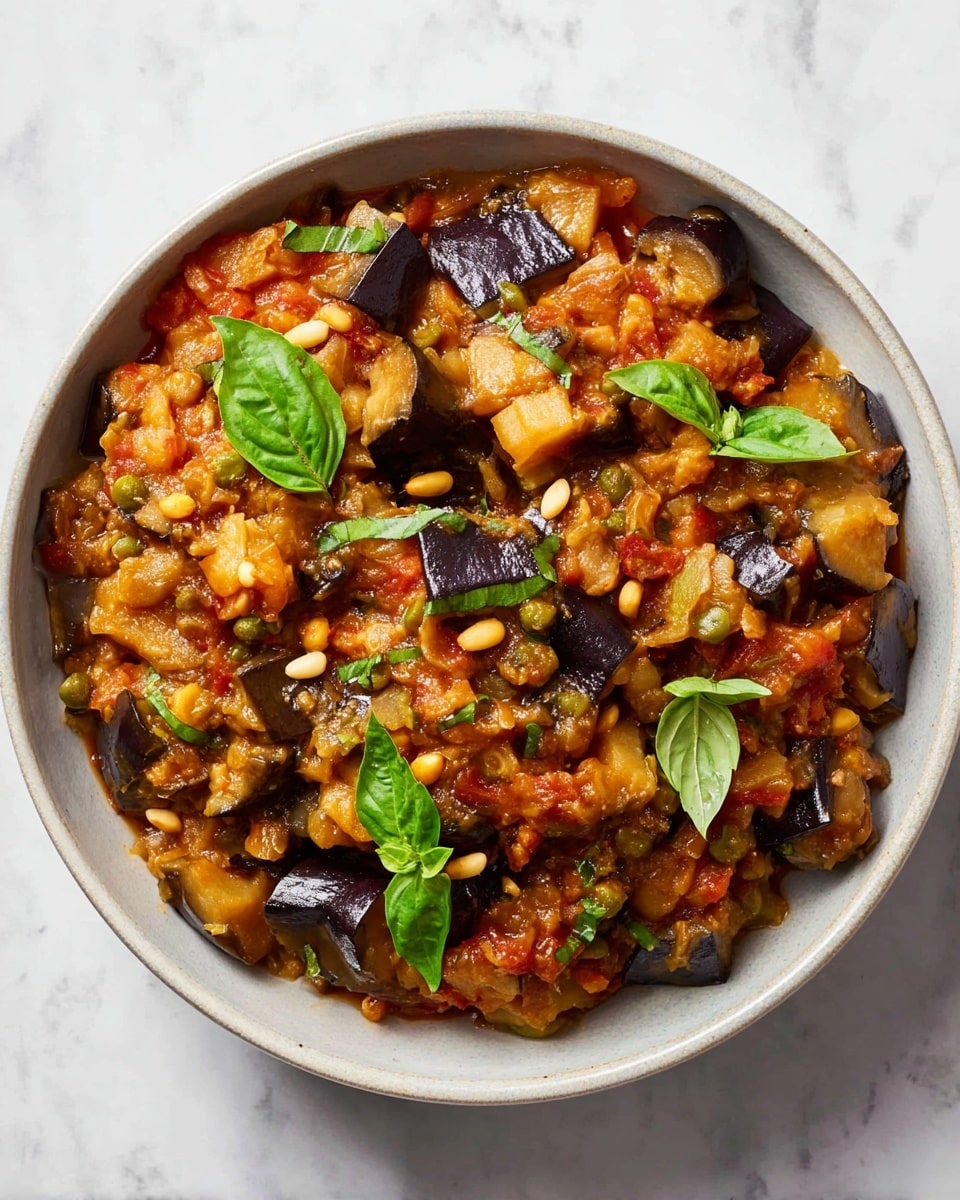
Ingredients You’ll Need
Each ingredient in this Eggplant Caponata Recipe plays a special role in building the vibrant, tangy-sweet flavor you’re after. When you shop, look for firm eggplants with shiny skin and ripe tomatoes for the freshest taste.
- Eggplant: I prefer globe eggplants for their creamy texture once roasted.
- Olive Oil: Use a good quality extra virgin olive oil to boost flavor.
- Kosher Salt: Its larger grain helps season evenly.
- Yellow Onion: Adds sweetness and depth when lightly sautéed.
- Celery: For that subtle crunch and aromatic bite.
- Whole Peeled Tomatoes: Canned are fine, just break them up well for that saucy goodness.
- Red Wine Vinegar: It gives that iconic tang to caponata.
- Granulated Sugar: Balances acidity and enhances sweetness naturally.
- Pine Nuts: Toasted to add rich, nutty texture.
- Capers: Their briny punch brightens the dish.
- Black Olives: They bring a hearty, savory finish.
- Fresh Basil: Torn over the top for a fresh herbal note.
Note: Exact ingredients and measurements are listed in the recipe card below.
Variations
I love how this Eggplant Caponata Recipe can flex depending on what you have in your pantry or your taste preferences. Feel free to adjust ingredients or toss in complementary veggies to make it your own.
- Additional Vegetables: I sometimes add diced bell peppers or zucchini when I want extra color and texture.
- Vegan Version: This recipe is already plant-based, but make sure your sugar is vegan if that’s important to you.
- Herbs Switch-up: Try oregano or parsley instead of basil for fresh variations; I’ve found basil works best for the classic flavor, though.
- Heat Factor: A pinch of red pepper flakes adds a nice gentle kick if you enjoy a bit of spice.
How to Make Eggplant Caponata Recipe
Step 1: Roast the Eggplant for Creamy Goodness
Start by preheating your oven to 425°F and arranging two racks so you can roast your eggplants on two large baking sheets. Toss the diced eggplant with olive oil and salt, then spread them evenly in a single layer. Roasting is key here because it brings a beautiful caramelized flavor and soft texture—as they turn golden and tender, about 25 minutes, you’ll know it’s time to move on. Don’t forget to toss halfway through so everything cooks evenly!
Step 2: Build the Flavor Base with Onion, Celery, and Tomatoes
While the eggplants roast, heat up your skillet with the remaining olive oil and sauté the diced onion until it’s translucent and lightly golden—about 4 minutes. Add sliced celery, canned tomatoes along with their juices, vinegar, and sugar, stirring as you break up the tomatoes. Bring this mixture to a gentle simmer to meld the sweet and tangy flavors perfectly before combining with the eggplant.
Step 3: Let the Magic Happen: Simmer and Meld
Once your eggplant is ready, add it along with pine nuts and capers to the skillet. Bring everything to a boil, then reduce the heat to medium-low and cover. Let this simmer for about 30 minutes, stirring occasionally, until the eggplant becomes meltingly tender and the sauce is thick and flavorful. Keep an eye out and add a splash of water if the mixture starts sticking to the pan.
Step 4: Final Touches with Olives and Basil
Turn off the heat and stir in the chopped black olives for that salty, meaty finish. Then, tear fresh basil leaves over the top—it’s such a simple addition but the aromas elevate the whole dish beautifully. You can serve your Eggplant Caponata warm or cold depending on your mood or the occasion.
Pro Tips for Making Eggplant Caponata Recipe
- Roast Eggplant Evenly: Cut your eggplant into uniform pieces so they cook at the same rate and get that lovely golden crust.
- Control Acidity: Taste as you go with the vinegar and sugar—adjust slightly to balance brightness and sweetness perfectly for your palate.
- Simmer Gently: Keep the heat low once boiling to avoid burning and to allow flavors to slowly meld into that classic caponata richness.
- Avoid Watery Mixture: Use a wide pan for roasting and simmering to help moisture evaporate, preventing sogginess.
How to Serve Eggplant Caponata Recipe

Garnishes
I’m a huge fan of finishing Eggplant Caponata with fresh torn basil for that burst of color and herbal aroma. Sometimes I add a sprinkle of toasted pine nuts on top, which gives a nice crunch and rich nutty flavor that complements the softness of the eggplant.
Side Dishes
This dish pairs beautifully with crusty bread or warm focaccia to scoop up all the saucy goodness. For a heartier meal, I like serving it alongside grilled chicken or a simply roasted fish. It’s also fantastic atop a bed of creamy polenta or alongside some fluffy couscous to soak up the flavors.
Creative Ways to Present
For a dinner party, I’ve served eggplant caponata in small glass jars or on toasted crostini as individual appetizers. It’s also beautiful layered in a shallow dish with fresh herbs, pine nuts, and olives scattered artistically. The vibrant colors make it a showstopper on any buffet or antipasto platter.
Make Ahead and Storage
Storing Leftovers
One of the things I adore about this Eggplant Caponata Recipe is how well it stores. I keep leftovers in an airtight container in the fridge for up to 4 days, and honestly, the flavors deepen and taste even better after sitting for a day or two.
Freezing
Freezing caponata is a great option if you want to save time in the future. I freeze portions in freezer-safe containers and find that it holds up surprisingly well. Just thaw overnight in the fridge before reheating gently.
Reheating
Reheat your caponata slowly on the stovetop over low heat, stirring occasionally to prevent sticking. I avoid the microwave because gentle warming preserves the dish’s texture better, keeping the eggplant creamy and the sauce luscious.
FAQs
-
Can I make Eggplant Caponata Recipe ahead of time?
Absolutely! In fact, Eggplant Caponata tastes even better after resting for at least a few hours or overnight, which allows the flavors to meld beautifully.
-
Is Eggplant Caponata Recipe gluten-free?
Yes, this traditional recipe is naturally gluten-free as it’s made with vegetables, vinegar, and nuts without any wheat-containing ingredients.
-
Can I substitute other vegetables in this caponata?
You sure can! Bell peppers, zucchini, or even mushrooms can be added or swapped in for a different twist, though eggplant remains the star of the dish.
-
What’s the best way to serve Eggplant Caponata Recipe?
Serve it warm or chilled as an appetizer, side dish, or spread on toasted bread—the versatility is part of its charm!
Final Thoughts
This Eggplant Caponata Recipe holds a special place in my kitchen because it’s so easy to make and reliably delicious every time. Whether you’re making it for a relaxed family lunch or an elegant appetizer for guests, it always impresses and brings smiles around the table. Trust me—you’ll enjoy discovering how a few simple ingredients can come together into something truly memorable and comforting. Give it a try and make it your own; I have a feeling it might just become a favorite in your home too!

